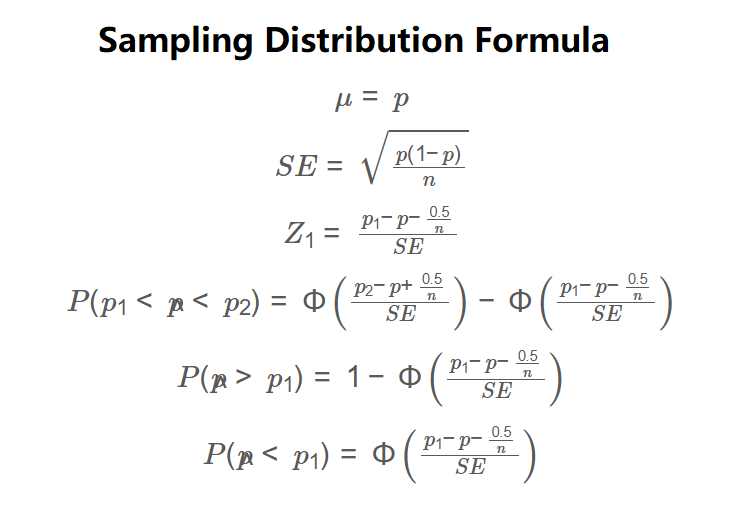 Home
Home
 Back
Back

Definition: The Sampling Distribution of Sample Proportion Calculator computes the mean, standard error, Z-score of a specified proportion, and probability that a sample proportion falls within a range or above/below a value, using the normal approximation.
Purpose: This tool helps researchers estimate the likelihood of sample proportions, useful in surveys, polls, and quality control to infer population characteristics.

The calculator uses the following formulas:
\( \mu = p \)
\( SE = \sqrt{\frac{p(1-p)}{n}} \)
\( Z_1 = \frac{p_1 - p - \frac{0.5}{n}}{SE} \)
\( P(p_1 < \hat{p} < p_2) = \Phi\left(\frac{p_2 - p + \frac{0.5}{n}}{SE}\right) - \Phi\left(\frac{p_1 - p - \frac{0.5}{n}}{SE}\right) \)
\( P(\hat{p} > p_1) = 1 - \Phi\left(\frac{p_1 - p - \frac{0.5}{n}}{SE}\right) \)
\( P(\hat{p} < p_1) = \Phi\left(\frac{p_1 - p - \frac{0.5}{n}}{SE}\right) \)
Where:
Steps:
Calculating sampling distribution probabilities is essential for:
Example: Calculate the probability that the sample proportion of iPhone owners is between 0.45 and 0.50, given a population proportion of 0.43 and sample size of 50:
Q: What is the sampling distribution of the sample proportion?
A: It is the probability distribution of sample proportions from repeated samples of size n, approximating a normal distribution when np and n(1-p) are ≥ 10.
Q: What is the Z-score of p₁?
A: The Z-score of p₁ measures how many standard errors p₁ is from the population proportion, adjusted for continuity correction.
Q: Why use a continuity correction?
A: The continuity correction adjusts for the discrete nature of the binomial distribution when using the normal approximation, improving accuracy.